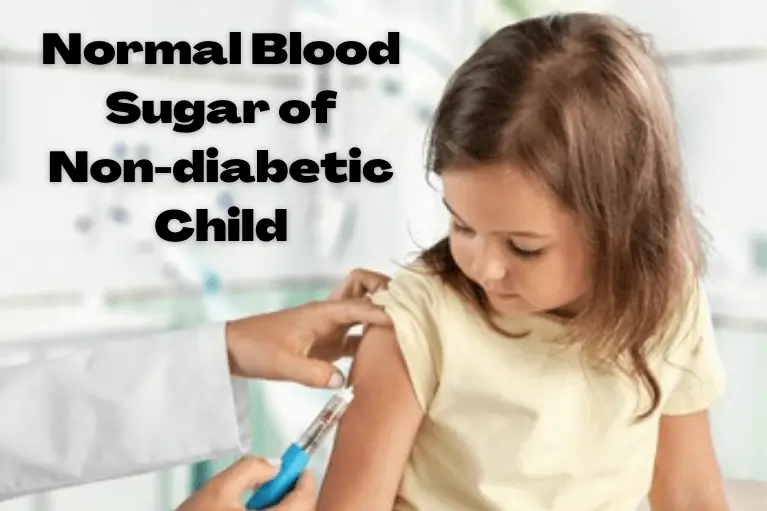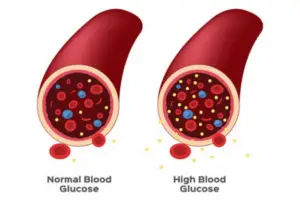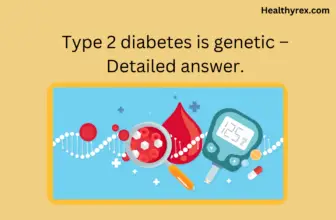Normal Blood Sugar of Non-diabetic Child

An understanding of normal blood sugar levels of your non-diabetic child is essential for you. Indeed your child is someone very special to you. So you need to keep yourself aware about his/her health. Since children mostly cannot describe their situation about health. So you should keep an eye on the activities of your child. If you feel any abnormality, then obviously it is alarming as your child eats a lot of sweet things so his/her blood sugar can be high at times. To avoid any severe consequences, you have to check your child’s blood sugar level.
After reading this article, you will be able to find your child’s average blood sugar level without diabetes. Moreover, you can also enhance your understanding of the normal blood sugar of children of different ages. Furthermore, I will discuss the normal blood sugar of adults too.
Random blood sugar level:
Random blood sugar level means you count your blood sugar randomly at any time. It means it is not time-specific, like before a meal or after the meal. Interestingly, random blood sugar level also has a target range. It should below 11.2mmol/L or in other unit <200mg/dL.

The normal blood sugar of non-diabetic adults:
We should have a look at the average blood glucose levels of a non-diabetic adult also. So the normal fasting blood glucose of a healthy adult ranges between 4.1-6.3 mmol/L.
Blood sugar levels after eating:
While after eating a meal, the normal blood glucose levels should be < 7.9 mmol/L.
What is the normal blood sugar of a child without diabetes?
Generally, different people assume slightly different levels of blood sugar normal. It may be a little bit confusing for you. But average normal blood sugar for the non-diabetic child should be as follows:
- Before breakfast (fasting), blood sugar should be 3.5-6.5mmol/L.
- After breakfast blood sugar should range between 8.8-11.2mmol/L
Normal blood sugar for the 6-year-old non-diabetic child:
Now let me tell you about the normal blood sugar of a non-diabetic child of 6 years or below. So if your child is non-diabetic and healthy, then he/she should have an average blood sugar level of 5.9-11.2mmol/L.in other units, it is 110-200mg/dL.
Normal blood sugar for the 7-year-old child:
As we know that blood sugar levels of children of different age groups vary. So now, I will discuss the normal blood sugar for children of 7 years old and above. Children of this age group should have a random blood sugar of 5.3-9.9mmol/L or 100-180mg/dL. Above this level, the sugar will be considered high.
Normal blood sugar for teenagers:
Since teenagers are metabolically and physically active, so their normal range of blood sugar is less than the children of smaller age groups. The random blood sugar level of 4.5-8.5mmol/L or 90-150mg/dL is average for them.
How does junk food affect blood sugar of your child?
The normal blood sugar of non-diabetic children may vary according to the condition since junk food contains a lot of calories and fats so it can raise the blood sugar of your child. Moreover, it can also increase cholesterol levels of your child.
So if your child is overeating junk and fast food, you should stop him/her from doing so. Regular intake of junk food can also make your child obese. So junk food is not suitable for your child’s health at any cost.

How do sweets affect the blood sugar of your child?
If your child is eating sweets, don’t you guess that his/her blood sugar will be high? Yes? You are right in your perception. But it is not much concerning as you are thinking. Because if your child is non-diabetic, then sugar levels will normalize after some time. However, if the condition persists long, then you should consult a doctor as soon as possible because it is not something healthy.
Non-diabetic hyperglycemia:
Even if your child is non-diabetic, he/she may experience hyperglycemia. It means glucose levels in the blood are higher than usual. Yet it is rare, but sometimes it may happen due to some major illness or injury. If this hyperglycemia persists longer, then it may be a possible cause of diabetes in the future.
Some possible symptoms of high blood sugar of your kid:
Since your child cannot describe his/her feeling of high blood sugar. Here are some indications that will help you to notice the problem
- Fatigue
- Increased thirst
- Increased hunger with weight loss
- Frequent urination
- The fruity smell in breath
Your child is experiencing these problems, and then you should consult a doctor.
What is prediabetes?
In all this scenario of blood glucose levels, another term is essential. That is prediabetes. As its name implies, prediabetes is glucose levels between normal and diabetes. It is higher than normal blood glucose levels but lower than diabetic levels.
But people that generally have higher than normal glucose levels are more likely to be affected by type II diabetes if your child is obese or has hypertension. Your child’s chances of prediabetes are enhanced.
What is the average A1c level of a child?
What is the A1c level? Your A1c level means how much percent of your hemoglobin is coated with sugar. Hemoglobin is a protein in your blood that carries and transports oxygen in your body. So higher A1c levels mean more elevated blood sugar.
If the A1c level of your child is below 7.5, then it is quite reasonable. It means your child is non-diabetic and healthy.
Normal insulin level in the child:
Insulin is a hormone that your pancreas produces to control your blood sugar. Since at different times, your child’s glucose levels are different, so insulin levels also vary.
- At fasting, insulin levels should be < 175pmol/L
- While after 1 hour of the meal it should be 130-1930pmol/L
Note that these are the recommended levels of insulin in children. While if your child has different insulin levels, then it may be due to some abnormality. Just like the regular blood sugar of non-diabetic children varies from diabetic, the insulin level also changes.
How to diagnose the blood sugar of your child?
There are several tests to diagnose hyperglycemia. Most of these tests include blood testing.
Random plasma glucose test:
Your doctor recommends this test if he does not want to wait for fasting. Just like a random blood sugar level, your doctor detects your blood sugar randomly.
Fasting blood sugar test:
This test is a blood test that includes 12 hours fasting period, after which your glucose level is tested. It is a beneficial test used even to detect prediabetes.
HbA1c test:
In this test, your A1c level is tested from the blood. As I have mentioned for children, the A1c level should below 7.6, and for adults, the range should be below 5.5. If it is more significant than 6.7, then it means you have diabetes.
Low blood sugar in a child without diabetes:
We have discussed that a non-diabetic child may have high blood glucose levels occasionally. In the same way, many times, your non-diabetic child may also face hypoglycemia. In many studies, low blood glucose levels of children without diabetes have been observed.
It is due to many reasons, e.g., fasting, prediabetes, enhanced production of insulin, or many other factors. Signs of low blood glucose of your child are similar to those of adults. These include
- Fatigue
- Sweating
- Confusion
- Double vision
- Hunger
- The feeling of being vomit
- Fainting
Can a non-diabetic child have ketone bodies in urine?
Ketone bodies are formed when someone’s body uses fats for energy rather than glucose. However, it happens in diabetic patients since their cells do not have sufficient glucose to use. Despite this, sometimes ketone bodies can also appear in the urine of non-diabetics due to some factors (non-diabetic ketoacidosis).
Due to this non-diabetic ketoacidosis, there may be ketone bodies in the urine of your non-diabetic child. You can detect them by a ketone test of your child’s urine. You have to do this test after you observe some symptoms. The main sign of non-diabetic ketoacidosis in your child is bad breath.
Some possible causes
Although it is not something usual, it can still occur due to some possible causes. For example
It may be due to low carbohydrate intake and digestive system disorders, e.g., chronic vomiting and diarrhea. However, it is also treated with insulin.
Difference between ketosis and ketoacidosis:
Another term that is associated with non-diabetic ketoacidosis is ketosis. Both are the same.
Ketoacidosis occurs in diabetic patients, while ketosis takes place in non-diabetic people.
Symptoms of diabetic ketoacidosis:
Symptoms of ketone bodies in urine are similar to those of hyperglycemia. These include abdominal pain, vomiting, and nausea, etc.
If you observe such symptoms in your child, you have to do the ketone test of your child.
How a diabetic child differs from a non-diabetic child?
How a diabetic child differs from a non-diabetic child?
Having diabetes is not unusual, but it is not easy, especially for children. Now we will see how a diabetic child varies from other non-diabetic children as he/she has diabetes, so he/she will experience some things that are not common in other children. These include:
- A diabetic child will feel more thirst than usual does.
- He/she will also feel more tired.
- He/she will suffer frequent urination, more than healthy children.
- There is also rapid weight loss.
The emotional and mental health of a diabetic child:
A diabetic child also lives in the same environment as healthy children, but conditions are not the same since he/she has diabetes, so he/she has to take care of more than others.
Such a child seems to be very responsible and selective in their eating habits. It is so because they know that eating more sugar can be dangerous for them. That is not the case with other healthy children.
Moreover, diabetic children that are on insulin therapy are more fearless of needles and syringes. Sometimes they may face more unsatisfactory health conditions than others. They may be more affected by infections. All these circumstances pose severe concerns over the mental health of diabetic children.
Target blood sugar of diabetic child:
A type I diabetic should have an average fasting blood glucose of 3.9-6.8 mmol/L. While after meal 4.9-8.9 mmol/L is the normal level. You can see that the average blood sugar of non-diabetic children differs from that of diabetic one.
What is essential for you to know about your child’s health?
Here are some essential things that you should know about your child.
- You should keep an eye on the behavior of your child.
- You should notice if you find some difference in his/her routine. For example, if your child is urinating more than usual.
- If your child mostly remains tired or feels fatigued even after some activity, ask a doctor.
- You should be frank enough that your child can discuss everything with you.
- Also, try to observe his/her social interactions with other his/her friends and fellows.
- If you feel any mood swings, then don’t ignore but find the reason.
- You should be educated enough that you know about the common medical thing. For example, what is the regular blood sugar of a non-diabetic child? Similarly, what are the symptoms of diabetes? etc.
How to keep your child healthy?
Don’t worry. Here are some tips that can keep your child healthy. Being a mother or father, you should do these simple things to keep your child healthy.
- Try to be the best friend of your child.
- You should try to avoid junk food and too much sweet to your child.
- Make sure that they are getting enough sleep.
- Help them in doing exercise.
- Routinely visit your child to a nearby pediatrician even if your child is healthy.
- Do not make them permanent of a sedentary lifestyle. Instead, keep them active.
- Give them small tasks, so they make a habit of doing his/her work by him/herself.
All these hacks will help you a lot in becoming a responsible parent.
FAQs:
Can a 6-year-old have type II diabetes?
Yes. Although a few decades ago, type II diabetes was considered to occur only in adults. But now it has observed that children can also have type II diabetes. Possibly it is due to the genetic factors that mean having a family history.
If child fasting blood sugar is 109 mg/L, is it normal?
No. If your child has blood glucose more than 125 mg/L, then he/she has diabetes. A blood glucose level of 109 mg/L is higher than usual. But actually, it means pre-diabetic, a state between normal and diabetic.
What is non- diabetic hyperglycemia?
Non-diabetic hyperglycemia means low blood sugar of non-diabetics. It may be due to thyroid abnormalities, increased production of insulin or fasting, etc. Its symptoms are almost similar to diabetic hyperglycemia.
Related Reading:






